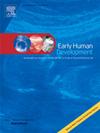产前接触阿片类药物的新生儿管理:实施发育护理计划的影响。
IF 2.2
3区 医学
Q2 OBSTETRICS & GYNECOLOGY
引用次数: 0
摘要
背景:管理产前接触阿片类药物的新生儿的传统方法以使用药物疗法(PT)为基础,并根据婴儿症状的变化进行调整。以非药物治疗(NPC)为重点的新方法正在兴起,但关于为确保其广泛应用而应实施的积极政策的证据却很少。本研究的主要目的是评估我们的新生儿医学科实施的发育护理计划是否对这些婴儿住院期间的管理产生了影响,尤其是对非药物护理的影响:方法:在一家三级围产中心进行观察研究。方法:在一家三级围产中心进行的观察研究。在宫内接触阿片类药物的婴儿住院期间收集的数据包括:在产科病房父母-婴儿病房(PIU)的入院情况、接触NPC和PT的情况、新生儿阿片类药物戒断综合征(NOWS)的发生情况、住院时间(LOS)和出院时的喂养类型。通过比较三个6年期来衡量干预措施的影响:第一个6年期是在实施正式发育护理计划之前(2003-2008年);第二个6年期是在实施该计划之后(2009-2014年);第三个6年期是在巩固该计划之后(2015-2020年)。从第一阶段到第三阶段,PIU 的入院率相当(68% 至 73%,p = 0.95)。接触鼻咽癌的比例从 37% 上升到 84%,p=0.95:一项积极的政策、支持培训和保障新生儿护理实践,对于减少子宫内暴露于阿片类药物的婴儿的用药量和住院时间至关重要。本文章由计算机程序翻译,如有差异,请以英文原文为准。
Management of neonates exposed prenatally to opioids: Impact of a developmental care program implementation
Background
Traditional approaches to management of neonates prenatally exposed to opioids are based on the use of pharmacotherapy (PT), adjusted to evolution of infant symptoms. Newer approaches focused on non-pharmacological care (NPC) are emerging, but there is little evidence on the active policies to implement to ensure their widespread practice. The primary objective of the study was to assess whether the implementation of a developmental care program in our neonatal medicine department had an impact on the management of these infants during hospitalization, notably exposure to NPC.
Method
Observational study in a tertiary perinatal center. Data collected during hospitalization for infants with in utero opioid exposure included admission in the parents-infant unit (PIU) of the maternity ward, exposure to NPC and PT, occurrence of neonatal opioid withdrawal syndrome (NOWS), length of hospital stay (LOS) and feeding type at discharge. The impact of the intervention was measured by comparing three 6-year periods, the first preceding the implementation of a formalized developmental care program (2003–2008); the second following implementation of the program (2009–2014); the third after consolidation of the program (2015–2020).
Results
258 infants prenatally exposed to opioid were recorded. From the first to the third period, admission rate in the PIU was comparable (68 % to 73 %, p = 0. 95). Exposure to NPC (37 % to 84 %, p < 0.001) increased, whereas exposure to PT (40 % to 15 %, p = 0.002) and LOS (13 [9–18] days to 8 [6–11] days, p = 0.003) decreased. NOWS occurred in 141 (55 %) infants (63 % to 47 %, p = 0.10). In these infants, decrease in PT was also observed (64 % to 34 %, p = 0.02). After adjustment for perinatal confounders, hospitalization in the PIU (OR 3.23 [1.36; 7.66]; p = 0.008), and the 2015–2020 period (OR 5.11 [2.06; 12.64]; p = 0.004) were associated with absence of PT.
Conclusions
An active policy, supporting the training and warranting the practice of NPC, is essential to reduce medication usage and length of hospitalization in infants exposed in utero to opioids.
求助全文
通过发布文献求助,成功后即可免费获取论文全文。
去求助
来源期刊

Early human development
医学-妇产科学
CiteScore
4.40
自引率
4.00%
发文量
100
审稿时长
46 days
期刊介绍:
Established as an authoritative, highly cited voice on early human development, Early Human Development provides a unique opportunity for researchers and clinicians to bridge the communication gap between disciplines. Creating a forum for the productive exchange of ideas concerning early human growth and development, the journal publishes original research and clinical papers with particular emphasis on the continuum between fetal life and the perinatal period; aspects of postnatal growth influenced by early events; and the safeguarding of the quality of human survival.
The first comprehensive and interdisciplinary journal in this area of growing importance, Early Human Development offers pertinent contributions to the following subject areas:
Fetology; perinatology; pediatrics; growth and development; obstetrics; reproduction and fertility; epidemiology; behavioural sciences; nutrition and metabolism; teratology; neurology; brain biology; developmental psychology and screening.
 求助内容:
求助内容: 应助结果提醒方式:
应助结果提醒方式:


